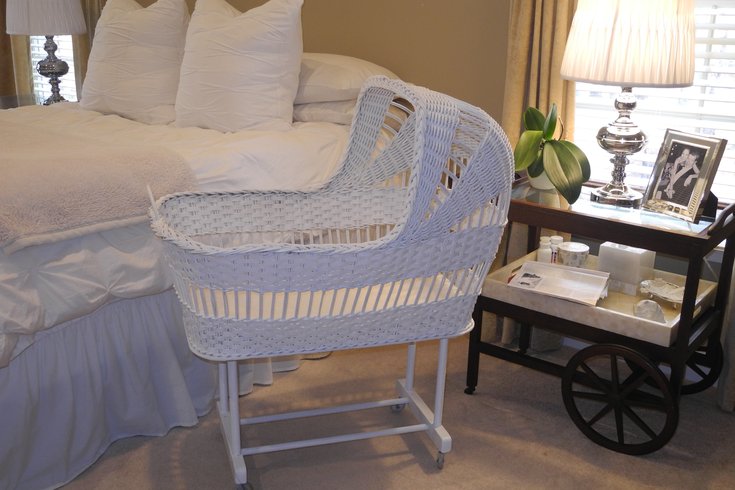
November 15, 2016
 Katie Gagnon/for PhillyVoice
Katie Gagnon/for PhillyVoice
Katie's baby sleeps next to his parents' bed in a bassinet handed down through three generations. Both Katie and her mother, as well as aunts, uncles, and cousins slept in this bassinet as babies.
My son sleeps 6 inches from me every night.
His basinet is close enough to my bed that I can reach over and place my hand on his chest to feel his breath rising and falling. There are a few reasons why my son sleeps in my bedroom.
When my baby boy wakes up in the middle of the night, hungry, he is in my arms in seconds. Having him so near allows me to monitor him throughout the night. Knowing that I can hear his every movement and reach him in an instant provides priceless peace of mind for this new Mama, allowing me to sleep. There is something sweet and special about my family of three sleeping together in the same room. But my reasons are more practical than precious, mainly in an effort to prevent a tragedy.
According to the American Academy of Pediatrics, the chances of SIDS are reduced by as much as 50 percent when infants share the same bedroom as parents. In new recommendations released late last month, the AAP recommends newborns sleep in the parents’ room, close to but not on the bed, ideally for a year but at least six months.
According to the AAP, “Placing the crib close to the parents’ bed so that the infant is within view and reach can facilitate feeding, comforting, and monitoring of the infant. Room-sharing reduces SIDS risk and removes the possibility of suffocation, strangulation, and entrapment that may occur when the infant is sleeping in the adult bed.”
There are approximately 3,500 sudden unexpected infant deaths of babies less than 1 year old annually in the United States, according to the Centers for Disease Control and Prevention. The thought of my baby dying in the middle of the night is enough to worry me into permanent insomnia, but sleep is so important to new mothers and fathers that we need to find ways to rest when our baby does.
So my husband and I are room-sharing and following all of the recommendations from the AAP to reduce the likelihood of SIDS, suffocation, strangulation, and entrapment. Our son is always put to sleep on his back. His basinet has no bumpers, pillows, stuffed animals or blankets except for the one in which he is swaddled.
His mattress is firm and flat; we give him a pacifier for naps and at bedtime; provide supervised tummy-time; and I breastfeed him. If my husband wants to enjoy a cigar, he does so outside and showers after he smokes before holding the baby. As first-time parents, all of these tasks seemed like a lot to remember initially, but it quickly has become part of our normal routine.
Rooming-in was highly recommended to my husband and me when we were preparing for our son’s arrival, so sharing the same space for sleep began on the first day of Killian’s life.
The hospital where he was born encourages room sharing for reasons beyond just keeping the baby safe at night. For mothers, the benefits include better sleep, improved breastfeeding, and a better understanding of the baby’s cues. For babies, the benefits of rooming-in include developing a more regular sleep cycle, more stable body temperature, less crying, less stress and better feeding.
For all of these reasons, rooming-in seems like a no brainer to me, but some parents may worry about sacrificing privacy and sleep by having their babies next to their beds. Having your child so near could hinder sexual intimacy, and if you wake at every little noise you will be hard pressed to reach REM.
To me, these concerns are far less important than keeping my son safe throughout the night.
I shared my fear of SIDS prior to my son’s birth when I wrote about deciding to purchase an oxygen and heart rate monitor for him. My husband and I had been cautioned that these monitors can create more grief than assurance, as false alarms cause unnecessary panic.
But the reviews I read about The Owlet were great. We used the monitor on our first night home from the hospital. After a dozen false alarms (resulting in a dozen of heart attacks), we decided to return the device. This may be why organizations like the AAP do not recommend SIDS monitors. For my family, diligent care and rooming-in trumps an expensive device.
My husband and I planned to have Killian sleep next to our bed for the first several weeks of his life, after which he would move to his nursery. The nursery is in our master bedroom suite, separated from our bedroom by glass French doors. He would be close to us and within earshot, but not right next to our bed.
After considering these new recommendations from the AAP, we have decided to keep Killian in our bedroom, next to our bed, for his first six months. Once he is 6 months old, he will sleep in his nursery, and eventually when he turns 1 year old, he will move down the hall to his own bedroom.
The first month of my baby boy’s life has passed in a flash, as I know the next 11 will. I am going to enjoy these precious moments of room-sharing, and the peace of mind knowing I am doing all that I can to ensure he makes it to his first birthday.
Do you or did you room-share with your infant? If so, for how long? Share your thoughts and tips in the comments section below or Tweet me @ThePhillyVoice and @KathleenEGagnon.